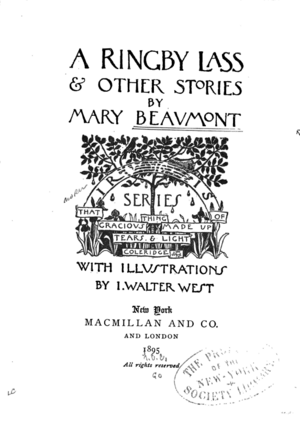Mary Beaumont (author) facts for kids
Mary Beaumont was the pen name of Rosa Oakes (born Mellor, 1849–1910). She was an author who wrote during the Victorian era.
Contents
About Mary Beaumont's Life
Mary Beaumont grew up in Halifax in Yorkshire, England. Her father, Enoch Mellor, was a clergyman. He and his wife Caroline raised their daughter in a family that valued faith and learning. In 1874, Mary married a manufacturer named John Oakes. They had two daughters together.
Mary Beaumont was lifelong friends with Robert Forman Horton (1855–1934). He was a well-known minister. Mary and her husband lived with Horton from 1902 until Mary's death in 1910. Horton later wrote about their deep friendship and how much he admired her.
Mary started writing when she was young. She published some poems in magazines by the time she was nineteen. However, she had health problems that made it hard for her to write a lot. She was not able to focus on being an author until the 1890s. Mary and Robert Horton also wrote poetry to each other. Some of their poems were published together as Poems by two friends.
What Did Mary Beaumont Write?
Mary Beaumont's first published stories appeared in Sunday Magazine. This magazine had Christian themes. One of her later works, The Valley of Stars, was published in parts over time.
Besides writing for magazines, Mary Beaumont also published at least three books:
- A Ringby Lass and Other Stories (1895)
- The novel Joan Seaton (1896)
- Two New Women and Other Stories (1899)
Many of her stories painted a clear picture of her home region, Yorkshire. Her books also showed how people thought about social issues in Victorian times. These included topics like colonialism and women's rights.
A Ringby Lass and Other Stories (1895)
This book is a collection of five short stories. They are "A Ringby Lass," "Jack," "The White Christ," "Miss Penelope's Tale," and "The Revenge of Her Race." The main story, "A Ringby Lass," takes place in Mary Beaumont's home area of Yorkshire. The story "Jack" is also set there.
The publisher, Macmillan, released this collection as part of its "Iris Series." The book was beautifully made, with pictures by I. Walter West. People liked the book's attractive look. The New York Times newspaper said it had a "charming" format and "delicate illustrations."
The Story "The Revenge of Her Race"
"The Revenge of Her Race" seems to be the most popular story in this collection. It was reprinted in a 1902 book called Stories by English Authors: The Orient. That collection also included Rudyard Kipling's famous story "The Man Who Would Be King." More recently, "The Revenge of Her Race" appeared in the 2004 Broadview Anthology of Victorian Short Stories.
This story is set in colonial New Zealand. It tells about a beautiful Maori woman named Maritana. She marries an Englishman. The story shows Maritana as a sad character. She is caught between two different cultures and dies young. The person telling the story feels sympathy for Maritana. However, the story also shows some of the unfair ideas about race that were common in the 1890s.
For example, one of Beaumont's English characters says that Maritana cannot fully become like an English person because of "something" in her "very blood." At the time, some people believed in ideas that are now known as "scientific racism." These ideas wrongly claimed that some races were naturally better than others. The New York Times commented on the story, saying it showed "exceeding truthfulness." They compared Maritana's situation to a "Zulu lad" who returned to "wild kindred." These views were based on harmful stereotypes and are not accepted today.
Joan Seaton (1896)
Like the main story in A Ringby Lass, the novel Joan Seaton is set in Yorkshire. It takes place in a made-up village called Percival-Dion. The book follows the lives of several local families who have known each other for many generations. Mary Beaumont's friend Robert Horton said that the village of Parsifal-Dion was based on the real village of Thornton Rust in Wensleydale.
Reviewers at the time praised the book. They liked how it showed the characters and the beautiful Yorkshire setting. Mary Beaumont often used Yorkshire in her stories. This made people see her work as part of a larger trend of British regional literature. One reviewer wrote that Mary Beaumont did for parts of Yorkshire what other famous authors did for Scotland. In 1912, Joan Seaton was published again as part of the Everyman's Library series.
Two New Women and Other Stories (1899)
This collection has ten stories. Reviewers liked that Mary Beaumont focused on kindness and good morals in these stories.
The main story, "Two New Women," is the longest. Its title refers to the "New Woman" idea. This was a big topic in Victorian times, about women gaining more independence. The story is set in Italy. An English engineer named Edward Molyneux meets two young women, Daphne Musgrave and Betty Chorley. He also meets Daphne's relative, Sir Reginald Musgrave.
The two women plan to have independent careers. Daphne wants to be a landscape gardener, and Betty wants to be a doctor. Daphne tells Edward that marriage is not needed for a happy life. She even suggests she might start a family by adopting a child. In another conversation, Betty tells Sir Reginald that rich people who do not work are like parasites. However, when Sir Reginald shows he is willing to work, Betty agrees to marry him. Daphne turns down Edward's marriage proposal. But he decides to stay her friend, hoping she might change her mind later.


